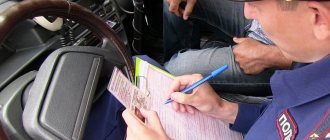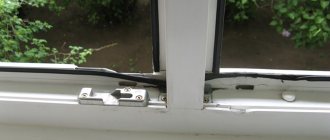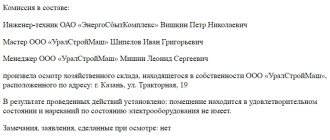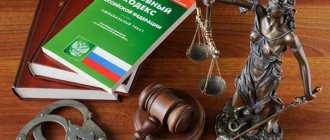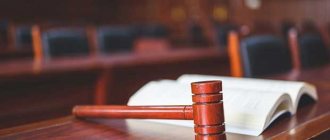Concept of crime scene inspection
Inspection of the scene of an incident is an investigative action consisting of examining the situation at the scene of an incident through direct perception using scientific and technical means. The scene of the incident is the premises or area where an event occurred that contained or may contain signs of a crime. The situation at the scene of the incident is the material structure of the place, including its characteristics, the main objects on it and their condition, their location relative to each other and other elements. The setting of the scene of the incident is an integral part of the incident itself. Its elements such as the behavior of the participants in the incident, the chronological characteristics of the event, the circumstances facilitating or hindering their actions, etc., are reflected in the situation.
An investigative examination is aimed at the perception, examination and recording of material objects. It is common and of great importance in an investigation.
The inspection has the main goal of studying the situation at the scene of the incident, identifying and recording traces of the incident and establishing its mechanism. Achieving this general goal is carried out through the implementation of intermediate tasks: it is necessary to establish what happened at the scene of the incident; the mechanism of trace formation, traces and objects that may have evidentiary value; the nature of the situation; if a crime has occurred, then – information about the identity of the criminal; time and method of committing a crime, its instruments and means. It is not always possible to resolve all of the above issues during an inspection of the crime scene, but it is necessary to strive for this.
As a procedural action, inspection of the scene of an incident also has a second main goal - identification: a comprehensive and complete recording of the situation and traces.
The content of the inspection consists in a consistent study of the situation at the scene of the incident, regulated by the criminal procedural law, through its direct perception by the investigator and the participants of the inspection. For comprehensiveness and completeness of the study, it is necessary to use scientific and technical means.
Inspection of the crime scene is an urgent, as a rule, initial and indispensable investigative action. Through the inspection, the investigator receives the bulk of the initial information necessary for organizing and carrying out other investigative actions and operational investigative activities. Based on the inspection data, taking into account the results of verification actions, the investigator makes a conclusion about the presence or absence of signs of a crime. That is why an inspection of the crime scene is allowed before a criminal case is initiated. Direct perception of the situation and research using scientific and technical means cannot be replaced by anything. Direct perception is indispensable for the investigator in a purely psychological sense, because it contributes to the creation of a mental model of the incident, which is important for other investigative actions (especially interrogations of the suspect and witnesses). During the inspection, samples of various substances and objects are often removed for subsequent examination.
Frontal method of inspection
In forensic science, methods of examining a crime scene are divided into three large groups: frontal, eccentric and concentric examination.
The frontal approach is otherwise called linear in science. In practice, it involves the tactics of exploring a large area of terrain; as a rule, this is not a room, but an open area. In accordance with this methodology, the entire territory is divided into strips, each of which has a starting and ending point. In most cases, the stripes run parallel, so they all have the same beginning and end, they are opposite each other. The width must be chosen so that each part of the territory can be clearly viewed by a person. For convenience, these stripes are marked materially with the help of pegs and rope (ribbon), so as not to be mistaken. This approach is one of the main methods of inspecting a crime scene, which is often used when the area is large.
Organizing an inspection of the scene of the incident
Inspection of the crime scene is a complex investigative action that requires high professional training of the investigator. The investigator is the organizer, leader and main executor of this investigative action. All other participants work under the direction of the investigator.
Participants in the inspection include specialists (depending on the nature of the incident and the situation on the spot, specialists from a variety of specialties may participate), operational and other employees of the investigative bodies. The investigator has the right to include a witness, victim, or suspect among the participants in the examination. The accused is rarely a participant in the inspection, because at the initial stage of the investigation such a procedural figure practically does not exist. As for the suspect, for tactical reasons it is generally not recommended to invite him to participate in the inspection.
Organizing an inspection of the scene of an incident includes preparation before going to the scene, defining and specifying the objectives of the inspection, planning it, mobilizing participants in the inspection, and guiding the conduct of the inspection by the investigator.
Organization begins with the self-organization of the investigator. He must be psychologically ready to go to the scene of the incident at any time and begin the investigation. This is achieved by high moral, psychological and professional qualities of the investigator, acquired in the process of life and upbringing, including while studying at a university and at work. The investigator's readiness directly affects his activity and the degree of organization of the examination.
The vast majority of incident reports are received by the duty units of the internal affairs bodies. They are entrusted with the responsibility of checking such messages (if necessary), recruiting investigative teams to go to the scene of the incident, maintaining contact with them, involving (if necessary) other police officers, and coordinating their activities.
At the same time, the investigator, as the head of the investigation, must monitor the process of creating an investigative and operational group and take measures to include the necessary persons in it; make sure that measures have been taken to protect the scene of the incident, preserve traces, etc. If necessary (for example, a report of an industrial accident was received by the investigative body), the investigator performs the listed actions personally. The investigator must keep in readiness the scientific and technical means necessary for the examination, as well as office equipment. Before leaving for the scene of the incident, he must ensure that they are ready. Depending on the nature of the scene and weather conditions, the investigator should be suitably equipped.
Upon arrival at the scene of the incident, the investigator makes sure that urgent measures to eliminate the consequences of the incident have been taken, the victim (if there is one) has been given assistance, the scene of the incident is guarded, etc. If not, he organizes their implementation and removes strangers from the scene of the incident. The investigator needs to briefly talk with eyewitnesses of the incident or persons who discovered it. If the police did this before the investigator arrived, then it is necessary to obtain primary information from them.
The investigator must carry out a preliminary (general) review of the crime scene. During its course, the investigator mentally compares the information received about the incident with visible traces and objects on the site, preliminarily determines the boundaries of the inspection, methods of spatial coverage of the place during the inspection and the sequence of upcoming actions. The preliminary survey is therefore aimed at a general perception of the situation on the site as a whole and planning for the upcoming inspection.
When planning the upcoming inspection, the investigator should be guided by the questions that need to be identified: what happened and the mechanism of the incident; time of incident; how many persons participated and information about these persons: the nature and motives of their actions; the nature of the relationship between the criminals and the victim, etc.
After a preliminary review, instructions may be given on the use of a service-search dog, on the pursuit of a criminal, on identifying the victim and other investigative actions. Some of these activities may occur prior to the preliminary review.
Before the inspection begins, the investigator instructs the participants, explains to them their rights and responsibilities and the need for active participation in the inspection.
Eccentric method
It is advisable to use it when the boundaries of the territory on which there are traces of a crime are difficult to determine. In this case, the investigator stands at the approximate center of the area, which is determined by eye. Such a center could be a safe that was broken into by a criminal, a corpse, a table, a closet, or something else that is of great importance to the case. The investigator's movements proceed in a spiral, from the center to the periphery. The scale is determined by the employee independently, depending on the details of the incident. Like the previous method, this one is used in most cases in open areas. Each method of conducting an inspection of a crime scene is unique in its own way and convenient in a particular case.
The eccentric and frontal methods are preferred when exploring open areas that are not limited by clear boundaries. Each approach has its own nuances that help the investigator in implementing the investigative action.
Tactical techniques for inspecting the scene of an incident
At the initial stage of the inspection, the investigator finds out and records the general characteristics of the scene of the incident, its size, location, and carries out orientation and overview photography or video recording.
Then the starting point of the inspection and the method of spatial coverage of the scene of the incident during the inspection are selected. The methods are divided into: concentric - from the periphery to the center, where the main actions of the criminal took place; eccentric – from the center of the event to the periphery; frontal (linear) – along parallel or adjacent sections; by sector - when the investigator mentally divides the entire scene of the incident into sections (sectors) and carries out an inspection, sequentially moving from one sector to another.
Inspection of the crime scene can be divided into general and detailed. This division is strictly observed in relation to individual sections of the crime scene, although it also applies to the entire inspection as a whole.
The choice of one or another method of spatial coverage (method of movement around the scene of the incident) depends on the specific situation of the inspection site. The chosen method should optimally contribute to the implementation of the general and. detailed inspection, its static and dynamic stages, their combination to achieve the inspection goals. In any case, the investigator must remember to be careful when moving around the scene of the incident in order to preserve traces, the location of objects on it, their condition, etc. There are situations when the tasks of a general inspection can be solved completely at its initial stage without the danger of changing the situation, after which the investigator begins a detailed investigation of the scene of the incident. More often, a situation arises when the investigator can only take an orientation and overview photograph of the scene of the incident and obtain information about the location of the place. Perform other general inspection tasks - measurements between objects, etc. – without disturbing the situation it is difficult. In such cases, the above problems are solved through a detailed study of individual nodes (sectors) of the incident site.
A detailed inspection consists of a sequential study of the situation at the scene of the incident by sector (node). The situation in the sectors is first studied statically: detailed and detailed photography of traces and objects is carried out, the distances between them are measured, and the location of these objects is established. The study is carried out visually, the position of objects does not change. Then a dynamic research method is applied: with the movement of objects, the use of scientific and technical means in order to identify various traces on objects, fix and remove these traces. The investigator must strive not to damage existing or hidden traces, not to leave his fingerprints, not to lose microparticles and not to introduce foreign ones during the examination. The inspection of the object ends with the recording of the trace (making a cast, etc.) or the removal of the object as a whole. In any case, before removal, the object must be returned to the same place from which it was moved for detailed inspection. The latter is especially important in cases where in the future it may be necessary to establish the exact distance between objects from different sectors.
When identifying traces, it is necessary to remember the provisions of traceology about the patterns of trace formation, about typical places where this or that trace may remain. When examining objects, one must be guided by the provisions of traceology that various traces, primarily microparticles, can remain on the body and clothing of a criminal. Therefore, the investigator removes samples of plants, soil, dust, microparticles of dyes and other substances for subsequent comparison with possible traces during further investigation. The same applies to instruments and means of committing a crime.
Even during the preliminary review, the investigator may have assumptions both about the event as a whole, its specific mechanism, and about its individual circumstances. In the process of a general and detailed examination, investigative versions of the mechanism of the incident are fleshed out and new ones arise. The concepts of objective and subjective methods are associated with the construction of versions during the inspection. The objective method involves a thorough inspection of the entire crime scene, and the subjective method involves the investigator following traces indicating the actions of the criminal at the scene. The investigative version built on their basis determines the actions of the investigator to identify alleged traces. At the same time, the investigator must still completely examine the entire space of the crime scene, keeping in mind assumptions about possible traces and looking for them, approaching the places where they should be. Objective and subjective examination methods should be used in combination. Only this tactic will make it possible not to miss other traces that are not related to the constructed version.
The noted situation is also associated with the discovery of negative circumstances - factual data that, based on the available evidence about the mechanism of the incident, should be absent or should necessarily be present, but they were not available. If negative circumstances are detected, the following conclusions can be made: the assumption about the mechanism of the incident is erroneous; a staging takes place. In any case, it is necessary to turn to the analysis of both investigative versions and the factual data on the basis of which these versions are built. Most often, negative circumstances indicate that the assumption about the mechanism of the incident is erroneous. But staging is also possible - the artificial creation or change by interested parties of the details of the situation at the scene of an incident in order to mislead the investigation. Staging is carried out to conceal a crime under the guise of an incident that does not have a socially dangerous nature; concealing one crime under the guise of another; concealing a crime under the guise of another crime allegedly committed by someone else.
In any case, when identifying negative circumstances, the investigator must try to differentiate all traces (in the broad sense of the word) from those formed as a result of the incident; contributed by interested parties; entered by unauthorized persons accidentally, unrelated to the incident; appeared due to objective reasons. Such an analysis will allow us to draw a conclusion about the mechanism of the incident, about the essence of certain of its circumstances.
Recording the progress and results of the inspection of the scene of the incident
Having completed the investigation of the situation at the scene of the incident, the investigator must analyze the collected factual data. Their assessment is done in relation to solving the main tasks of the inspection: what was revealed, what could not be established. At this point, it is advisable to carry out a control inspection of the most important components of the incident site.
Drawing up a protocol for examining the scene of an incident is possible in two versions. In the first case, rough notes are made during the inspection, and then a protocol is immediately drawn up. In the second case, the protocol is drawn up immediately during the inspection by the technical participant under the dictation of the investigator. The second method is more optimal, since the investigator examines the scene of the incident without being distracted by technical work, which in itself is very important. In any case, the protocol is read out by the investigator. This not only has procedural significance, but also allows the investigator to mentally repeat the action just performed, identify any omissions and immediately eliminate them through a selective re-examination.
The following requirements apply to the incident scene inspection protocol:
- the progress and results of the inspection must be reflected fully, accurately and objectively;
- The protocol should consist of clear and preferably short phrases. The expressions “near”, “next to”, “close”, etc. are unacceptable;
- When describing an object, its general and specific characteristics are indicated (name, purpose, shape, size, color, etc.). In the protocol, the object must have the same name;
- if when describing the characteristics or the object as a whole there is no confidence in the correct name, then only general external signs are indicated (a red-brown stain similar to blood; a yellow metal watch, etc.);
- the name of the scientific and technical means used, technical characteristics and conditions of use, who used them are indicated;
- It must be noted which objects were seized from the scene of the incident, copies of which traces were made, samples of which substances were seized and packaged;
- the annexes to the incident scene inspection protocol (plans, diagrams) are indicated.
Seized objects are packaged and provided with appropriate inscriptions and tags signed by the investigator. Schemes and plans are attached to the protocol. The diagram is drawn without exact correspondence of the relative sizes of space and objects. It indicates in numbers the main dimensions of objects and the distances between them. The most common overview diagrams reflect the actual scene of the incident. If necessary, nodal and detailed diagrams are drawn, reflecting individual parts of the incident site. The orientation diagram shows the scene of the incident along with the surrounding area.
Plans, unlike diagrams, provide a large-scale representation of the scene or parts of it. Plans and diagrams can be detailed. The unfolded ones depict not one, but several planes (floor, walls, sometimes ceiling), on which it is necessary to reflect objects or traces important for inspection (blood, scratches, etc.).
Final stage
At this stage of the work, methods of recording the results of the inspection of the scene of the incident are already applied - all the necessary documents are drawn up. The investigator checks whether all the activities that were planned at the first stage have been implemented; if necessary, diagrams and drawings are drawn up that will help in further work. Traces of a crime, evidence, objects are individually packaged and sent to an expert center or laboratory. If there is a corpse, it is sent to the medical examiner's office. Preliminary results are summed up and an assessment of the committed act is given, the investigator builds tactics for conducting the investigation and orients the direction of work.
